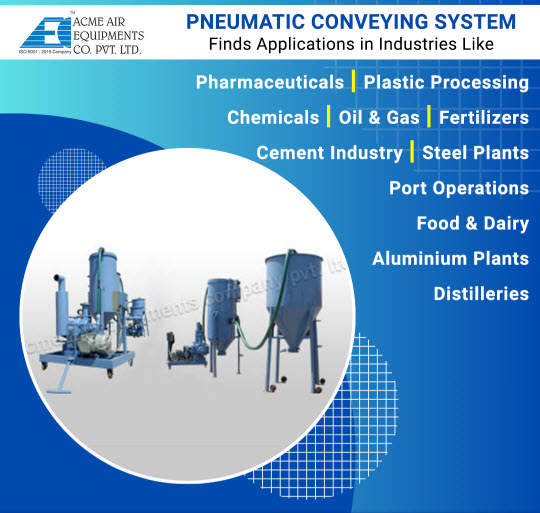In the ever-evolving landscape of material handling, innovative solutions play a pivotal role. Among these, the Pneumatic Conveying System stands out as a game-changer. This article aims to explore the manifold advantages associated with this cutting-edge technology, offering insights into how it can revolutionize diverse industries.
Understanding Pneumatic Conveying
A. Definition and Functionality
At its core, a Pneumatic Conveying System is designed to transport materials efficiently using air pressure differentials. Understanding its basic principles is crucial to grasp its advantages fully.
B. Types of Pneumatic Conveying Systems
Industries vary, and so do their material handling needs. This section will delve into the different types of pneumatic conveying systems, highlighting their specific applications.
Advantages of Pneumatic Conveying Systems
A. Efficient Material Handling
One of the foremost advantages of pneumatic conveying systems is their ability to handle materials with unparalleled efficiency. This section will explore the mechanisms behind this efficiency, discussing how it positively impacts overall operational processes.
B. Dust-Free Operation
Dust emissions can be a significant concern in industrial settings. Pneumatic conveying systems address this issue by ensuring a dust-free operation. We’ll delve into how this is achieved and its implications for a cleaner and healthier work environment.
C. Flexibility in Layout
Unlike traditional material handling systems, pneumatic conveying systems offer remarkable flexibility in layout and installation. This part of the article will elaborate on how this adaptability caters to the specific spatial constraints of different industries.
D. Minimal Maintenance Requirements
Maintenance costs can be a substantial burden on businesses. Pneumatic conveying systems stand out for their minimal maintenance requirements, contributing to long-term cost-effectiveness. This section will outline the key features that reduce the need for frequent maintenance.
E. Versatility in Material Transportation
Materials come in various forms and compositions. Pneumatic conveying systems showcase their versatility by efficiently transporting a wide range of materials. This segment will discuss the diversity of materials these systems can handle.

F. Environmental Friendliness
In an era where environmental sustainability is a top priority, pneumatic conveying systems shine as eco-friendly solutions. This part of the article will elaborate on the green aspects of these systems and their alignment with modern environmental standards.
G. Reduction in Labour Intensity
Automation is a driving force in modern industries. Pneumatic conveying systems contribute to this trend by reducing the need for manual labour in material handling processes. This section will discuss the implications for operational efficiency and workforce optimization.
H. Preservation of Material Integrity
Certain industries demand the utmost integrity in handling materials. Pneumatic conveying systems, with their gentle material handling approach, ensure the preservation of material integrity. We’ll explore how this is achieved and its importance for industries that prioritize product quality.
I. Enhanced Safety Measures
Safety is paramount in any industrial setting. Pneumatic conveying systems integrate advanced safety features, providing a secure working environment for operators and employees. This section will detail the safety measures in place and their role in preventing accidents.
J. Energy Efficiency
Energy consumption is a critical consideration in industrial operations. Pneumatic conveying systems boast energy-efficient designs, contributing to reduced operational costs and a greener footprint. This part of the article will delve into the specific features that make these systems energy-efficient.
K. Space Optimization
Space constraints are a common challenge in industries. Pneumatic conveying systems address this by optimizing space utilization. This section will discuss how these systems contribute to efficient use of available space.
L. Real-Time Monitoring and Control
In the era of data-driven decision-making, real-time monitoring and control are invaluable. Pneumatic conveying systems offer advanced monitoring features, providing businesses with actionable insights. This part of the article will elaborate on the importance of real-time control in optimizing material handling processes.

M. Quick and Reliable Material Transfer
Time is of the essence in industrial processes. Pneumatic conveying systems excel in ensuring quick and reliable material transfer. This section will highlight the speed and reliability factors that make these systems indispensable for time-sensitive operations.
N. Cost-Efficiency in the Long Run
Summarizing the overarching theme of cost-effectiveness, this section will encapsulate how the advantages of pneumatic conveying systems translate into financial benefits for businesses, both in the short and long term.
Conclusion
In conclusion, the advantages of adopting a Pneumatic Conveying System are diverse and impactful. From efficiency and safety to sustainability and cost-effectiveness, these systems present a holistic solution to modern material handling challenges. Embracing this technology positions industries for a future where material handling is not just efficient but also optimized for success.
FAQs About Pneumatic Conveying Systems
Yes, pneumatic conveying systems are versatile and can handle a wide range of materials, from powders to granules and even fragile products.
Pneumatic conveying systems reduce the environmental impact by minimizing dust emissions and energy consumption, aligning with green and sustainable practices.
No, these systems are designed for minimal maintenance requirements, contributing to their cost-effectiveness in the long run.
Absolutely, pneumatic conveying systems are highly adaptable and can be customized to meet the unique requirements of various industries.
Pneumatic conveying systems incorporate safety features such as real-time monitoring, automatic shutdown in case of anomalies, and employee training, ensuring a secure working environment.



